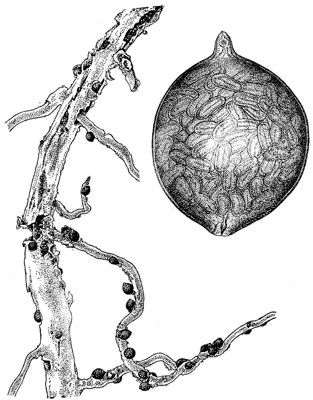Pests
Heterodera humuli Filipjev - Hop Cyst Nematode
Systematic position.
Phylum Nematoda, class Secernentea, order Tylenchida, suborder Hoplolaimina, superfamily Hoplolaimoidea, family Heteroderidae, genus Heterodera.Biological group.
Obligate parasite.Morphology and biology.
Female is lemon-shaped, white; its anal-vulval cone is small. Body is 0.33-0.69 mm in length, 0.30-0.60 mm in width. Male is vermiform, transparent, with body length 0.7-0.96 mm. Eggs are oval, 0.089 x 0.042 mm; vermiform larvae of I and II instars (0.316-0.480 mm) develop there. The II instar larvae invade roots, being mobile in wet soil. Their further development takes place in roots after penetration, where the larvae become sedentary and feed by the cell sap surrounding the nematode head end. The middle part of their bodies is thickening, and after molting they develop into bottle-like larvae of III instar, and then into thicker lemon-shaped larvae of IV instar. The larvae of IV instar develop into females or males (rolled inside cuticle), depending on food supply. The swollen larval bodies break off the root bark; mobile males penetrate into soil, and the females remain immersed into root tissue by their head end. After insemination, the females continue feeding and produce eggs. All the eggs remain in the body of females who die by autumn and turn into cyst. The Hop Cyst Nematode has one generation that lasts 34-56 days, depending on the environmental conditions. The latent period for eggs and larvae in cysts is unknown.Distribution.
Chuvashia is the only zone of wide distribution (more than 30% of the area is infested) and high severity of H. humuli. This situation is probably conditioned by insufficient survey of hop fields in other regions. The Hop Cyst Nematode is also found in three Regions of Ukraine, being harmful in Zhitomir Region only. This nematode occurs and harms in many European countries, in the USA, Canada, New Zealand, and South Africa.Ecology.
The species is inadequately investigated. The optimal soil temperature for the H.humuli development in plant roots is 25°C. This nematode prefers heavy soils. The species has a strict specialization; the main host plant is hop, but H.humuli can also survive in common nettle (Urtica dioica).Economic significance.
The infestation of plant roots by H. humuli leads to hop yield decrease of 50% and to deterioration of its quality. The yield losses depend on the nematode population density this in soil in spring and on plant growth stage. A decrease in the survivability of hop cuttings has been also recorded.Reference citations:
Danilova Yu.S. 1996. Bio-ecological justification of control measures of hop against hop cyst nematode Heterodera humuli Filipjev, 1934. PhD Thesis. Moscow: TSKhA. 22 p. (in Russian).Dmitriev D.V. 1950. Nematode is a dangerous hop pest. Michurinets 4: 15. (in Ukrainian).
Kir'yanova E.S., Krall' E.L. 1971. Parasitic plant nematodes and their control. V.II. Leningrad: Nauka. 405 p. (in Russian).
Zinov.ev V.G., Volodchenko Z.G. 1968. Hop cyst nematode. Zashchita rastenii 8: 52. (in Russian).


